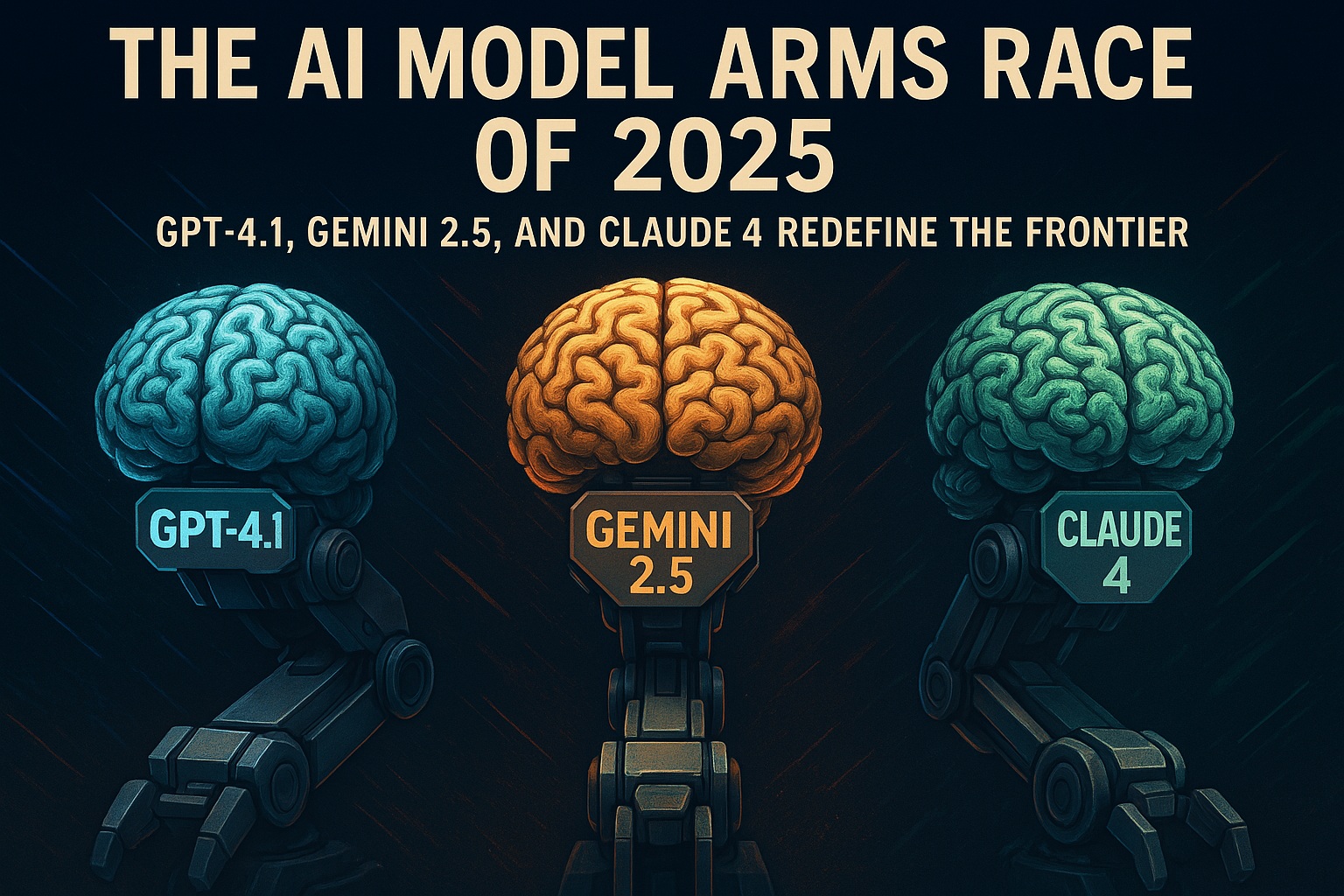🧠 The AI Model Arms Race of 2025: GPT-4.1, Gemini 2.5, and Claude 4 Redefine the Frontier

The artificial intelligence landscape in 2025 is undergoing a seismic shift, as three of the world’s leading AI labs—OpenAI, Google DeepMind, and Anthropic—have released their most advanced models to date. These next-generation systems—GPT-4.1, Gemini 2.5, and Claude 4—are not just incremental upgrades. They represent a leap forward in reasoning, multimodal understanding, and real-world task execution.
🔷 OpenAI’s GPT-4.1: Long Context, Fast Execution, and Agentic Power
OpenAI’s GPT-4.1 family, launched in April 2025, includes three models: GPT-4.1, GPT-4.1 Mini, and GPT-4.1 Nano. These models are available exclusively via API and are designed to outperform their predecessors—GPT-4o and GPT-4.5—across nearly every benchmark.
Key Features:
- 1 million-token context window, enabling deep document analysis and long conversations
- 27% improvement in coding tasks over GPT-4.5, scoring 54.6% on SWE-bench Verified
- Improved instruction following, with a 10.5% gain on MultiChallenge benchmarks
- Nano model optimized for low-latency tasks like classification and autocomplete, with 83% lower cost than GPT-4o Mini
OpenAI has also begun deprecating GPT-4.5 Preview, with full retirement scheduled for July 14, 2025, as GPT-4.1 offers better performance at lower cost.
🔶 Google’s Gemini 2.5: Multimodal Mastery and Deep Reasoning
Google’s Gemini 2.5 Pro and Gemini 2.5 Flash are now the flagship models in its AI arsenal. Released in mid-2025, these models are designed for text, image, audio, and video inputs, and are available via the Gemini app, Vertex AI, and Android/iOS platforms.
Highlights:
- Deep Think Mode: A new reasoning engine that evaluates multiple hypotheses before responding, mimicking human deliberation
- Gemini Live: Enables real-time screen and camera sharing for interactive AI assistance on mobile and desktop
- Efficiency Gains: Gemini 2.5 Flash reduces token consumption by 20–30% while improving performance, making it ideal for enterprise use
- Benchmark Dominance: Gemini 2.5 Pro scored 336/360 on India’s IIT JEE Advanced exam—beating the top human scorer
Gemini’s integration into Android Auto, Wear OS, and Google Home is also underway, signaling Google’s ambition to make AI ubiquitous across its ecosystem.
🔷 Anthropic’s Claude 4: Coding Powerhouse with Extended Thinking
Anthropic’s Claude 4 series, released in May 2025, includes Claude Opus 4 and Claude Sonnet 4. These models are built for advanced reasoning, coding, and autonomous agent tasks, and are available via the Anthropic API, Amazon Bedrock, and Google Cloud Vertex AI.
Standout Features:
- Claude Opus 4 leads all models in coding, scoring 72.5% on SWE-bench and 43.2% on Terminal-bench
- Extended Thinking Mode: Allows Claude to allocate more computational resources for complex, multi-step problems
- Tool Integration: Claude can use external tools like web search and file access during reasoning sessions
- Claude Code: Now generally available, with native IDE support for VS Code and JetBrains, enabling seamless pair programming
Anthropic has also introduced Claude Haiku 4, a lightweight model expected to be upgraded later this year.
🧭 Comparative Snapshot
| Feature | GPT-4.1 (OpenAI) | Gemini 2.5 (Google) | Claude 4 (Anthropic) |
|---|---|---|---|
| Context Window | 1 million tokens | 1 million tokens | Extended memory + tools |
| Multimodal Input | Text, image (API only) | Text, image, audio, video | Text, code, tools |
| Reasoning Engine | Instruction-following | Deep Think Mode | Extended Thinking Mode |
| Coding Benchmark (SWE) | 54.6% | 61.2% (est.) | 72.5% |
| Availability | API only | Web, mobile, Vertex AI | API, Bedrock, Vertex AI |
🧠 The Bigger Picture
The 2025 AI model race is no longer just about chatbots—it’s about building intelligent agents that can reason, code, see, hear, and act. These models are being embedded into everything from IDEs and productivity suites to mobile apps and autonomous systems.
As OpenAI, Google, and Anthropic continue to push the boundaries, the next frontier may not be just smarter models—but models that can think, plan, and collaborate with humans in real time.



0 Comments
No comments yet, be the first to comment